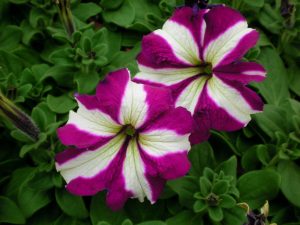Starting annual flowers from seed in a greenhouse or under lights isn’t a whole lot different from starting tomatoes. There are still flowers you can start in April, and it’s a nice thing to do when the perennials are up 6 inches but there are still snowflakes in the air. Outdoors, the garden may not be able to figure out if it’s spring yet, but inside the greenhouse, you can control the weather, so you can plant flowers.
You may wonder why it’s worth it to start annuals, since it’s so easy and relatively cheap to buy colorful bedding plants nowadays. The reasoning is the same as for starting your own tomatoes: You get to choose your varieties, without having to shop around looking for just the right blue salvia or white cosmos.
Like tomatoes, most of our colorful bedding annuals are subtropical plants. Their seeds won’t germinate in cold soil. You could wait and sow seeds outdoors until the ground has thoroughly warmed up—no sooner than late May around here in Chicago—but by the time the plants start flowering, the summer will be half over. That’s why we like to give our plants a head start, so when we set them out after the last frost, they’re within a few weeks of blooming.
You can start a few annual flowers in a sunny windowsill or under plant lights in the basement or garage, if you can spare the space from the tomatoes. If I had a choice between giving space to annuals or to my favorite tomatoes, the tomatoes would win. But in a greenhouse, you can spare the space for flowers.

The seed packet will give you the exact timing. Some annuals, such as ageratum, annual geraniums, and petunias, need a longer time to get started, and should be planted in February or March. But early April should do it for celosia, cleome, marigolds, and moss roses. Wait a couple of weeks longer for cosmos; they can sometimes bloom in as few as four weeks from seed, and if you start them too early you may find them flowering indoors before they ever make it to the garden.
Here’s a handy chart from the University of Missouri Extension that suggests general seed starting dates and gives another important piece of information: whether the seeds need light to germinate. Some flower seeds are sensitive to day length as well as temperature. You not only need to give them a warm environment, around 65 degrees, but you also need to set them under lights for 14 to 16 hours a day to trick them into thinking the springtime is farther advanced than it is.
A warm place to sprout; fine-textured, sterile seed-starting mix; light; watering from the bottom so the soil stay evenly moist; and patience: Those are the main ingredients for a garden of cheerful annuals. And careful labeling. Nothing is less fun, when it’s finally time to set out the transplants on a fine May morning, than realizing you don’t know which of your carefully chosen varieties is which.










